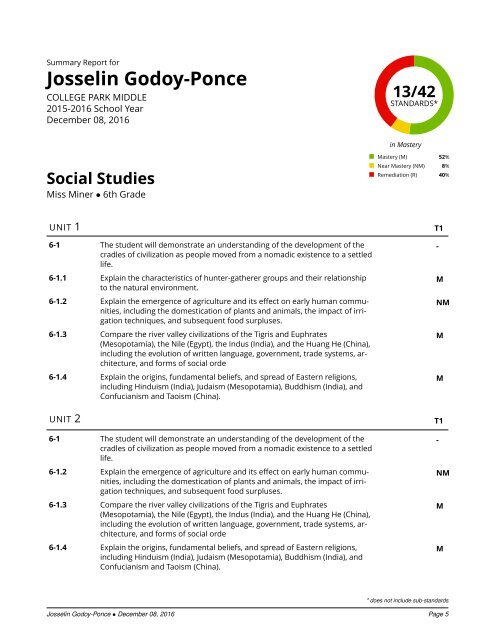josselin-godoy-ponce-progress-report
You also want an ePaper? Increase the reach of your titles
YUMPU automatically turns print PDFs into web optimized ePapers that Google loves.
Summary Report for<br />
Josselin Godoy-Ponce<br />
COLLEGE PARK MIDDLE<br />
2015-2016 School Year<br />
December 08, 2016<br />
13/42<br />
STANDARDS*<br />
in Mastery<br />
Social Studies<br />
Miss Miner • 6th Grade<br />
Mastery (M) 52%<br />
Near Mastery (NM) 8%<br />
Remediation (R) 40%<br />
UNIT 1<br />
6-1 The student will demonstrate an understanding of the development of the<br />
cradles of civilization as people moved from a nomadic existence to a settled<br />
life.<br />
6-1.1 Explain the characteristics of hunter-gatherer groups and their relationship<br />
to the natural environment.<br />
6-1.2 Explain the emergence of agriculture and its effect on early human communities,<br />
including the domestication of plants and animals, the impact of irrigation<br />
techniques, and subsequent food surpluses.<br />
6-1.3 Compare the river valley civilizations of the Tigris and Euphrates<br />
(Mesopotamia), the Nile (Egypt), the Indus (India), and the Huang He (China),<br />
including the evolution of written language, government, trade systems, architecture,<br />
and forms of social orde<br />
6-1.4 Explain the origins, fundamental beliefs, and spread of Eastern religions,<br />
including Hinduism (India), Judaism (Mesopotamia), Buddhism (India), and<br />
Confucianism and Taoism (China).<br />
UNIT 2<br />
6-1 The student will demonstrate an understanding of the development of the<br />
cradles of civilization as people moved from a nomadic existence to a settled<br />
life.<br />
6-1.2 Explain the emergence of agriculture and its effect on early human communities,<br />
including the domestication of plants and animals, the impact of irrigation<br />
techniques, and subsequent food surpluses.<br />
6-1.3 Compare the river valley civilizations of the Tigris and Euphrates<br />
(Mesopotamia), the Nile (Egypt), the Indus (India), and the Huang He (China),<br />
including the evolution of written language, government, trade systems, architecture,<br />
and forms of social orde<br />
6-1.4 Explain the origins, fundamental beliefs, and spread of Eastern religions,<br />
including Hinduism (India), Judaism (Mesopotamia), Buddhism (India), and<br />
Confucianism and Taoism (China).<br />
T1<br />
-<br />
M<br />
NM<br />
M<br />
M<br />
T1<br />
-<br />
NM<br />
M<br />
M<br />
* does not include sub-standards<br />
Josselin Godoy-Ponce • December 08, 2016 Page 5



